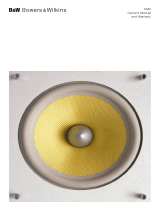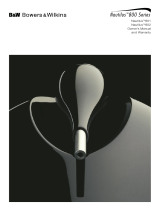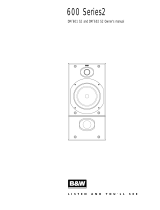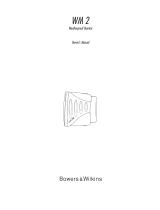Page is loading ...

Nautilus
TM
800
Owner’s Manual
and Warranty

Figure 1
Figure 2
Figure 3a
Figure 4
>0.5m
>2m
≈≈
≈
Figure 3b
Figure 5

Contents
English
Limited Warranty...........1
Owner’s Manual............1
Français
Garantie limitée.............3
Manuel d’utilisation .......3
Deutsch
Beschränkte
Garantie .......................6
Bedienungsanleitung.....6
Español
Garantía limitada...........9
Manual de
instrucciones ................9
Português
Garantia limitada.........12
Manual do utilizador....12
Italiano
Garanzia limitata .........14
Manuale di istruzioni ...15
Nederlands
Beperkte garantie .......17
Handleiding ................17
Dansk
Begrænset garanti ......20
Brugsanvisning ...........20
Svenska
Begränsad garanti ......22
Bruksanvisning ...........22
Ελληνικά
Περιρισµένη
εγγύηση....................24
δηγίες ρήσεως ....25
Русский
Ограниченная
гарантия....................28
Руководство по
эксплуатации ............28
.......................31
.....................31
.......................33
....................33

English
Limited Warranty
Dear customer,
Welcome to B&W.
This product has been designed and
manufactured to the highest quality
standards. However, if something does go
wrong with this product, B&W
Loudspeakers and its national distributors
warrant free of charge labour (exclusion
may apply) and replacement parts in any
country served by an official B&W
distributor.
This limited warranty is valid for a period of
five years from the date of purchase or two
years for electronics including amplified
loudspeakers.
Terms and Conditions
1 The warranty is limited to the repair of
the equipment. Neither transportation,
nor any other costs, nor any risk for
removal, transportation and installation
of products is covered by this warranty.
2 This warranty is only valid for the
original owner. It is not transferable.
3 This warranty will not be applicable in
cases other than defects in materials
and/or workmanship at the time of
purchase and will not be applicable:
a. for damages caused by incorrect
installation, connection or packing,
b. for damages caused by any use other
than correct use described in the user
manual, negligence, modifications, or
use of parts that are not made or
authorised by B&W,
c. for damages caused by faulty or
unsuitable ancillary equipment,
d. for damages caused by accidents,
lightning, water, fire heat, war, public
disturbances or any other cause
beyond the reasonable control of B&W
and its appointed distributors,
e. for products whose serial number has
been altered, deleted, removed or
made illegible,
f. if repairs or modifications have been
executed by an unauthorised person.
4 This guarantee complements any
national/regional law obligations of
dealers or national distributors and
does not affect your statutory rights as
a customer.
How to claim repairs under
warranty
Should service be required, please follow
the following procedure:
1 If the equipment is being used in the
country of purchase, you should
contact the B&W authorised dealer
from whom the equipment was
purchased.
2 If the equipment is being used outside
the country of purchase, you should
contact B&W national distributor in the
country of residence who will advise
where the equipment can be serviced.
You can call B&W in the UK or visit our
web site to get the contact details of
your local distributor.
To validate your warranty, you will need to
produce this warranty booklet completed
and stamped by your dealer on the date of
purchase. Alternatively, you will need the
original sales invoice or other proof of
ownership and date of purchase.
Owner’s manual
Introduction
Thank you for choosing Bowers & Wilkins.
Your Nautilus™800 speakers are precision
transducers incorporating many innovative
techniques unique to B&W and capable of
reproducing recorded sound to the highest
standards. So that they may perform at
their best, it is essential to take time and
care with the installation process. In
particular, you must regard the listening
room as an extension of the speaker. The
acoustic character of the room can have a
profound effect on the final sound quality.
Please read this manual fully before
unpacking and installing the product. It will
help you to optimise its performance. B&W
maintains a network of dedicated
distributors in over 60 countries who will be
able to help you should you have any
problems your dealer cannot resolve.
Unpacking (figure 1)
The product is extremely heavy and will
require more than one person to unpack
and position it safely.
We recommend you wear gloves and
strong shoes to avoid personal injury in
case of accident. Observe the normal rules
of good posture when lifting heavy objects
to avoid strain. Remove any rings and
bracelets to avoid damage to the surfaces
of the product.
• By the time you read this manual, the
carton should be lying on the floor with
the speaker face up, as indicated by
the printing on the side of the carton.
• Remove the lower packing tray to
expose the plinth of the speaker.
• Open the bag and pull it clear of plinth.
• Stand the speaker upright and remove
the remainder of the packing.
• Remove the transit clamp from the rear
of the speaker, following the instruction
on the label. (This reveals a large
slotted tensioning screw. The position
of the screw is factory set to optimise
the anti-vibration mount of the
midrange driver and should not be
altered).
We suggest you retain the packing for
future use.
Check in the accessory pack for:
4 foot receptacles
4 Screw-in spike foot tips (pre-fitted to
receptacles)
4 Screw-in foot pads
1 Midrange unit centre-bullet
1 Midrange unit grille
1 Allen key
1 Foot adjustment bar
1 Cleaning Cloth
1 Leather Cleaner
(odd numbered carton only)
Wood is a natural material and veneers vary
between batches. Although supplied as
single units, systems with consecutive
serial numbers (odd number lower) have
veneer-matched cabinets. Please be aware
that if more than two speakers are
purchased for a single installation, B&W
cannot guarantee they will all be veneer
matched.
Positioning (figure 2)
The speakers are provided with ball glides
on the underside of the plinth to facilitate
movement.
However, to prevent the weight of the
speaker causing damage to non-carpeted
floors, place a piece of felt or carpet under
the plinth and slide the speaker into
position. To manoeuvre the speaker without
tipping, push low down on the cabinet.
Both spike feet (for carpeted floors) and
padded feet (for wooden and other
vulnerable floors) are provided as an
alternative to the roller ball glides. However,
we do not recommend you fit these until
after the optimum position for the speakers
has been determined.
To find the optimum position in the room
may involve a certain amount of
experimentation, but as an initial guide:
• Position the speakers and the centre of
the listening area approximately at the
corners of an equilateral triangle.
• Keep the speakers at least 2m apart to
maintain left-right separation.
• The speakers are designed to be free-
standing and will generally perform
best when positioned at least 0.5m
(20-in) from walls.
The proximity of the speakers to walls
affects the sound quality. See the section
“Fine Tuning” below.
Stray magnetic fields
The speaker drive units create stray
magnetic fields that extend beyond the
boundaries of the cabinet.
We recommend you keep magnetically
sensitive articles (television and computer
screens, computer discs, audio and video
tapes, swipe cards and the like) at least
0.5m from the speaker.
Connections (figure 3)
All connections should be made with the
equipment switched off.
The high quality WBT® terminals accept a
variety of cable terminations to suit most
applications. For either 6mm (1/4 in) or
8mm (5/16 in) spades, use the larger
diameter section of the screw caps. For
1

4mm banana plugs, use the smaller
diameter section of the screw caps, which
loosens or tightens a collet round the plug.
In all cases, make sure both sections are
screwed down in use to prevent rattling.
Important safety notice:
In certain countries, notably those in
Europe, the use of 4mm banana plugs is
considered a potential safety hazard,
because they may be inserted into the
holes of unshuttered mains supply sockets.
In order to comply with European
CENELEC safety regulations, the 4mm
holes in the ends of the terminals are
blocked by plastic pins. Do not remove the
pins if you are using the product where
these conditions apply.
There are 2 pairs of terminals at the back of
the speaker. The outermost (LF) pair feed
the bass drivers and the innermost (MF/HF)
pair feed the midrange and tweeter. This
separation of the inputs to each section of
the speaker allows a choice of connection
methods.
On delivery, both positive and both negative
terminals are connected together with high-
quality links for use with single 2-core
cable. If you wish to use single cable
connection, the links must be left in place.
Because high frequency signals are more
readily degraded by contact connections,
we recommend you connect the cable
directly to the innermost (MF/HF) terminals
(figure 3a). Even if you finally intend to use
a more complex connection method, single
cable connection aids free movement of the
speakers during initial setting up. There is
enough clearance to fit a spade connector
on top of a link.
Separation of the signal paths to each
section of the speaker can improve imaging
and the resolution of low-level detail and
allows the user to optimise the cable to the
frequency range of use. Bi-wiring involves
the use of two separate 2-core cables from
the same amplifier, one to each pair of
terminals on the speaker. Bi-amplification
involves the use of two separate power
amplifier channels for each speaker. In both
cases, the links should be removed from
the speaker terminals (figure 3b).
Ensure each positive terminal on the
speaker (coloured red) is connected to the
positive output terminal of the amplifier and
negative (coloured black) to negative.
Incorrect connection may result in
impairment of frequency response, poor
imaging and loss of bass.
If using bi-amplification, ensure that each
amplifier channel has the same gain,
otherwise you will change the balance of
the speaker. Check the absolute polarity.
Some amplifiers invert the signal, and a
mixture of different types may cause a dip
in the overall response. If you have a
mixture of inverting and non-inverting
amplifiers, reverse the polarity of the
connections from any inverting amplifier to
the speaker. Bear in mind that, even
though midrange and, even more so,
tweeter drivers can (and only need to)
handle less continuous power than bass
drivers, the amplifier feeding them needs to
have an adequate voltage swing in order to
supply the short–term high–frequency
peaks in music without distortion. A high
voltage capability implies high power, so it
is not particularly desirable to have a lower
power amplifier feeding the midrange and
tweeter than is used for the bass drivers.
Fine tuning
Before fine tuning, double check that all the
connections in the installation are correct
and secure.
Positioning the speakers:
Moving the speakers further from the walls
will reduce the general level of bass. Space
behind the speakers also helps to create an
impression of depth. Conversely, moving
the speakers closer to the walls will
increase the level of bass.
If the bass is uneven with frequency it is
usually due to the excitation of resonance
modes in the room.
Even small changes in the position of the
speakers or the listeners can have a
profound effect on how these resonances
affect the sound. Try mounting the
speakers along a different wall. Even
moving large pieces of furniture can have
an effect.
If the central image is poor, try moving the
speakers closer together or toeing them in
so they point at or just in front of the
listeners. (figure 4)
Room acoustics:
If the sound is too harsh, increase the
amount of soft furnishing in the room (for
example use heavier curtains), or reduce it
if the sound is dull and lifeless.
Test for flutter echoes by clapping your
hands and listening for rapid repetitions.
Reduce them by the use of irregular
shaped surfaces such as bookshelves and
large pieces of furniture.
If you still suffer poor results due to the
acoustics of the listening room, consult
your dealer about more substantial acoustic
treatment.
Fitting the alternative feet: (figure 5)
Most speakers perform best, particularly in
terms of bass attack and timing, given a
firm mechanical foundation. Unless you
wish to move the speakers on a regular
basis, we recommend you replace the ball
glides on the underside of the plinth with
the alternative feet supplied.
Switch off the equipment and disconnect
the cables from the terminals.
• Use at least two people to manoeuvre
the speaker. Remove rings and
bracelets to avoid scratching the
speaker surfaces.
• Lay the speaker on its back, resting on
the polystyrene packing cradle to
protect it from the floor.
• Replace the ball glides with the conical
foot receptacles, using the Allen key
provided.
• If you have a carpeted floor, fully screw
in the spike foot tips, otherwise use the
flat foot pads.
• Return the speaker to the upright
position.
• If the speaker rocks on two of the feet,
unscrew the other two feet equally,
using the bar provided, until the
speaker stands firmly on the floor.
If the seating position is particularly low, the
speaker may be tilted forward. The spike
may be extended to a maximum of 45mm
(1.75in) from the foot receptacles. Screw
the front two feet in as far as possible and
extend the rear feet evenly to suit. Adjust
the rear feet to eliminate rocking and
tighten the lock nuts.
Fitting the midrange grille:
A grille is supplied in the accessory pack to
cover the midrange drive unit if desired.
Fitting the grille also requires the centre
bullet of the drive unit to be replaced by the
alternative version with a hole in the tip
from the accessory pack.To fit the
alternative centre bullet, simply unscrew the
fitted part and screw in the replacement,
taking care not to damage the voice coil
former. Hand tighten only.
Running-in period
The performance of the speaker will change
subtly during the initial listening period. If
the speaker has been stored in a cold
environment, the damping compounds and
suspension materials of the drive units will
take some time to recover their correct
mechanical properties. The drive unit
suspensions will also loosen up during the
first hours of use. The time taken for the
speaker to achieve its intended
performance will vary depending on
previous storage conditions and how it is
used. As a guide, allow up to a week for
the temperature effects to stabilise and
60 hours of average use for the mechanical
parts to attain their intended design
characteristics.
Ancillary equipment
Speakers of this ability deserve signals of
the highest quality. Choose your electronic
equipment and interconnecting cables with
care. We can give guidance on what to
look for when choosing ancillary
equipment, but cannot recommend specific
items. The standards of such products are
improving all the time and your dealer will
be able to demonstrate a variety of suitable
up-to-date products.
In the specification we recommend a range
of amplifier powers. The higher figure is
defined by the power handling capability of
the speaker. When calculating the power
handling, it is assumed that the amplifier is
not run into clipping, which distorts the
frequency power spectrum of the signal,
and that the signal is normal programme
material. Test tones from oscillators and the
like are not applicable. The lower figure is
the minimum we consider necessary to
achieve reasonable listening levels without
audible distortion in the smaller room (less
than 60 m
3
or 2000 cu ft). The higher the
power you use, the less likely you are to
experience amplifier clipping. You can often
tell how good an amplifier is at driving
complex speaker loads by looking at its
power rating into both 4Ω and 8Ω loads.
2

The nearer the ratio is to 2:1 the better, as
it indicates a good current capability.
In order to reduce the effect the cable has
on the frequency response of the speaker
to inaudible levels, the impedance of the
cable at all frequencies (measuring both
positive and negative conductors in series)
should be kept as low as possible and
certainly below 0.1Ω. At low frequencies,
the DC resistance of the cable is the
dominant factor and you should choose a
gauge of wire sufficient to achieve the
impedance requirements over the length of
cable you need to use. At mid and high
frequencies the inductive component of the
impedance can dominate the DC
resistance. This and other properties
influenced by the detailed construction of
the cable become important. Ask your
dealer for advice on the best cable for your
needs.
Aftercare
Most of the enclosure surfaces simply
require dusting and you may use the cloth
provided in the accessory pack to wipe
small marks from the gloss surfaces. The
surfaces may also benefit from the
occasional use of an antistatic cleaner.
However, such cleaners may damage the
leather covering the top and front of the
bass cabinet and the drive units
themselves. For that reason, do not spray
from an aerosol directly onto the product.
Apply the cleaner first to a soft cloth, but
for this purpose, do not use the cloth
provided in the accessory pack.
The leather cleaner supplied in the
accessory pack will maintain the quality of
the leather on your speakers for many
years. If you wish to use it on other leather,
we advise you test it first on an unobtrusive
area of the article, DO NOT USE THIS
PRODUCT ON ANILINE (UNFINISHED)
LEATHER.
In its diluted form, the leather cleaner is
supplied to remove ingrained dirt, grime
and mild grease deposits.
Directions for use:
1) Make a solution of one part cleaner to
twelve parts very hot water.
2) Immerse a soft cloth in this solution,
wring out cloth and rub lightly over the
surface to be cleaned.
3) Remove an residue of cleaner solution
with a fresh cloth dampened with clean
water.
Avoid touching the drive unit diaphragms,
especially the tweeter, as damage may
result.
Français
Garantie limitée
Cher Client,
Bienvenue à B&W.
Ce produit a été conçu et fabriqué en vertu
des normes de qualité les plus rigoureuses.
Toutefois, en cas de problème, B&W
Loudspeakers et ses distributeurs
nationaux garantissent une main d’œuvre
(exclusions possibles) et des pièces de
rechange gratuites dans tout pays desservi
par un distributeur agréé de B&W.
Cette garantie limitée est valide pour une
période de cinq ans à compter de la date
d’achat ou une période de deux ans pour
les composants électroniques, y compris
les haut-parleurs amplifiés.
Conditions
1 La garantie est limitée à la réparation
de l’équipement. Les frais de transport
ou autres, les risques associés à
l’enlèvement, au transport et à
l’installation des produits ne sont pas
couverts par cette garantie.
2 La garantie est exclusivement réservée
au propriétaire d’origine et ne peut pas
être transférée.
3 Cette garantie ne s’applique qu’aux
produits faisant l’objet de vices de
matériaux et/ou de construction au
moment de l’achat et ne sera pas
applicable dans les cas suivants :
a. détériorations entraînées par une
installation, connexion ou un emballage
incorrect,
b. détériorations entraînées par un usage
autre que l’usage correct décrit dans le
manuel de l’utilisateur, la négligence,
des modifications ou l’usage de pièces
qui ne sont pas fabriquées ou agréées
par B&W,
c. détériorations entraînées par un
équipement auxiliaire défectueux ou
qui ne convient pas,
d. détériorations résultant de : accidents,
foudre, eau, chaleur, guerre, troubles
de l’ordre public ou autre cause ne
relevant pas du contrôle raisonnable de
B&W ou de ses distributeurs agréés,
e. les produits dont le numéro de série a
été modifié, effacé, éliminé ou rendu
illisible,
f. les produits qui ont été réparés ou
modifiés par une personne non
autorisée.
4 Cette garantie vient en complément à
toute obligation juridique nationale /
régionale des revendeurs ou
distributeurs nationaux et n’affecte pas
vos droits statutaires en tant que
client.
Comment faire une réclamation
en vertu de la garantie
Veuillez respecter la procédure ci-dessous,
si vous souhaitez faire une réclamation
sous garantie :
1 Si l’équipement est utilisé dans le pays
d’achat, veuillez contacter le
distributeur agréé de B&W qui a vendu
l’équipement.
2 Si l’équipement est utilisé dans un
pays autre que le pays d’achat, veuillez
contacter le distributeur national B&W
du pays de résidence, qui vous
indiquera où vous pouvez faire réparer
l’équipement. Vous pouvez appeler
B&W au Royaume-Uni ou consulter
notre site Web pour obtenir les
coordonnées de votre distributeur local.
Afin de valider votre garantie, vous devrez
présenter ce livret de garantie qui aura été
rempli et tamponné par votre revendeur le
jour de l’achat. En l’absence de ce livret,
vous devrez présenter l’original de la
facture commerciale ou une autre preuve
d’achat et de la date d’achat.
Manuel d’utilisation
Introduction
Nous vous remercions d’avoir choisi
Bowers & Wilkins.
Vos enceintes acoustiques de la série
Nautilus™800 sont des transducteurs de
précision, comprenant de nombreuses
techniques innovantes, uniques à B&W.
Elles sont capables de reproduire vos
enregistrements au niveau de qualité le plus
élevé. Pour obtenir les meilleures
performances, il est essentiel de consacrer
le temps et l’attention nécessaires à leur
installation. En particulier vous devez
absolument considérer que la salle
d’écoute est une extension acoustique des
enceintes. Le tempérament acoustique de
la salle peut donc avoir une influence
profonde sur la qualité sonore finale.
Nous vous recommandons de lire
attentivement ce manuel avant de déballer
et d’installer les appareils. Il vous aidera à
optimiser leurs performances.
B&W a constitué un réseau de distributeurs
dans plus de 60 pays. Ils sont en mesure
de vous assister au cas où votre revendeur
ne pourrait vous aider.
Deballage (figure 1)
Ces matériels sont extrêmement lourds. Ils
requiérent plus d’une personne pour un
déballage et une mise en place exempts de
risques. Nous vous recommandons
d’utiliser des gants et des chaussures
solides ; ils vous protègerons de toute
blessure éventuelle. Vous observerez les
règles élémentaires de bonne posture qui
sont applicables lorsque l’on soulève un
objet lourd et encombrant ; elles vous
éviterons un éventuel tour de reins. Retirez
bagues et bracelets pour ne pas risquer de
rayer la surface de l’appareil.
• Couchez le carton sur le sol, face
avant de l’enceinte orientée vers le
haut, conformément aux indications
imprimées sur l’emballage.
3

36
Nautilus
TM
800
Technical Features
Description
Drive units
Frequency range
Frequency response
Dispersion
Sensitivity
Harmonic distortion
Nominal impedance
Crossover frequencies
Power handling
Max. recommended cable impedance
Dimensions
Net Weight
Nautilus
TM
tweeter
Nautilus
TM
head
Kevlar
®
brand fibre cone FST midrange
Matrix cabinet
Flowport
3-way vented-box system
1x ø25mm (1in) metal dome high-frequency
1x ø150mm (6in) woven Kevlar
®
cone FST midrange
2x ø250mm (10in) paper/Kevlar
®
cone bass
-6dB at 25Hz and 50kHz
-3dB at 32Hz and 42kHz
37Hz - 23kHz ±2dB on reference axis
Within 2dB of response on reference axis
Horizontal: over 60º arc
Vertical: over 10º arc
91dB spl (2.83V, 1m)
2nd and 3rd harmonics (90dB, 1m)
<1.0% 45Hz - 20kHz
<0.5% 50Hz - 20kHz
8Ω (minimum 3.0Ω)
350Hz and 4kHz
50W – 1000W into 8Ω on unclipped programme
0.1Ω
Height: 1197mm (47.1 in)
Width: 450mm (17.7 in)
Depth: 645mm (25.4 in)
125kg (275 lb)
/













